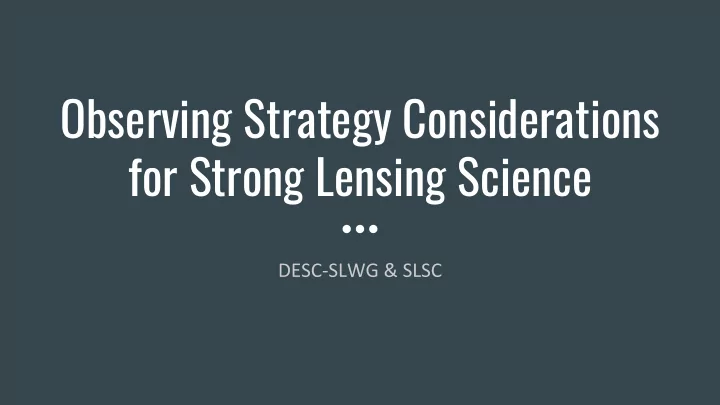

Observing Strategy Considerations for Strong Lensing Science
Intro Strong gravitational lensed are rare events (1 in 10 4 galaxies ● capable of being a lens) ● Requirements for general strong lens discovery: ○ Wide area with reasonable sensitivity in all bands (increases sample size) ○ Good image quality (to discern lensed images from lenses, better R ein sampling, accurate image positions) ○ Blue sensitivity (detect typically blue SFGs) ● Strongest observing constraints: ○ Strong gravitational lens time delays (lensed QSOs & SNe) ○ This talk: LSST considerations only, but in practice, high resolution imaging and spectroscopy follow-up are typically required
A quick word on static lenses Theoretical Einstein Radius distribution Most lenses have small Einstein radii. ‘Log number of lenses’ Most lensed sources are blue. Some of the good seeing time should be allocated to g-band. This will maximise LSST’s strong lens discovery potential. Einstein Radius Collett 2015
Strongly Lensed Variable Sources Light from a multiply imaged background source takes different paths through the lens potential Variable background sources Lens model have differences or time Predict the delays delays in their periodic variability 1/H 0
Quasar Time Delays ● Discovery ○ Single visit depth yields few thousand lensed QSOs (Oguri & Marshall 2010) ○ ~few hundred suitable for time delay science (Liao et al. LSST cadenced 2015) observations (+ Single galaxy detailed follow-up) lenses have best ● Cadence can provide the determined models ○ Capture delays of several needed few % days - several weeks precision on time delay distance ● Considerations ○ Night-to-night cadence Need ~100 such time delay systems ○ Season length to constrain H 0 to ○ Campaign length sub-percent level
Time Delay Challenge 1 Liao, Treu, Marshall, et al. 2015 ● 5 different i-band light curve datasets (“rungs”) ● 1000 lenses in each ● Challenged the community ● Assessed results through ○ Time delay accuracy ○ Time delay precision ○ Usable sample fraction
TDC1 precision, accuracy, success fraction - as an approximate function of observing strategy diagnostic
MAF Analysis Sky maps of lensed quasar time delay accuracy, for minion_1016 Accuracy improves with campaign length (known). Bottom: 10 years, cf Center: 5 years Use all filters to increase night-to-night cadence. Top: ri only, cf Bottom: ugrizy
ugrizy improves distance precision from 0.42% to 0.24% (10 years) kraken_1043: early attempt to split visit pairs, shows marginal improvement in distance precision over baseline.
Better time sampling improves time delay precision Alt_sched gives improvement over baseline by almost a factor of 2
Rolling cadence may not be best for lensed QSO time delays Fewer seasons with good sampling - so accuracy falls. Need to compromise on accuracy threshold. Then, precision is comparable between rolling cadence and baseline. Need to revisit definitions in metrics!
Lensed Quasars: Cadence Needs Maximize sky area, plus all three of season length, night-to-night cadence, and campaign length (no. of seasons). Alt-sched sims (Huber & Suyu) show significant improvements in success fraction and dt precision. However, mothra_2045 rolling cadence seems to give approximately similar performance (Anguita et al, yesterday), but metrics need modifying to compute performance year-by-year. Note on TDC2 DESC project, to be rebooted this year. Variety of cadence strategies. Multi-filter (TDC1 was i-band only). Lensed SNe time delays - better probe than QSOs?
Goobar et al. 2017 SN time delays from LSST Look for high luminosity SNe in elliptical “hosts” ~900 lensed SL SN 1a in WFD (Goldstein & Nugent 2017, Goldstein et al. 2018) ~100 (1a and cc) SNe spatially resolved (Oguri & Marshall 2010, Goldstein & Nugent 2017) suitable for time delay analysis Goldstein & Nugent 2017 Kelly et al. 2015, 2016
Lensed SNe time delays vs cadence simulate lensed SNe light curves measure time delay PyCS given LSST cadence strategy (Tewes++2013, Bonvin++2016) alt_sched_rolling performs best: recover dt input within ~4% Slide from S. Suyu & S. Huber
Lensed SNe: Cadence Needs Lens sample size increases linearly with sky area and campaign length. Cadence needs are similar to unlensed SNe: higher night-to-night cadence is better. Alt-sched sims (Huber & Suyu) show best dt precision: 4% per system LSST only: time delays possible for only 10% lensed SNe and need higher cadence to achieve 4% accuracy Higher cadence = lower area: discover proportionally fewer lensed SNe for follow-up (i.e. with LGSAO, HST, JWST, Euclid, WFIRST, etc.).
Recommend
More recommend